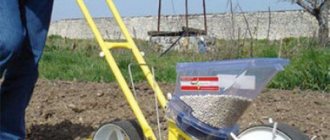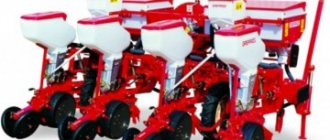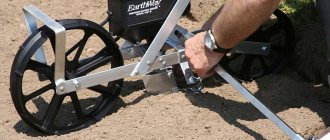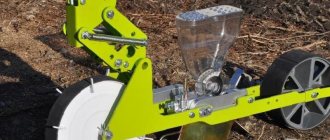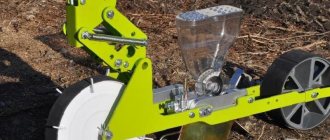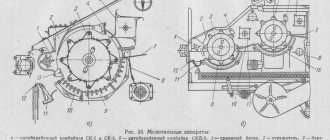Homemade products from a washing machine engine:
1. How to connect a motor from an old washing machine through a capacitor or without it 2. Homemade emery from a washing machine engine 3. Homemade generator from a washing machine engine 4. Connecting and adjusting the speed of a commutator motor from an automatic washing machine 5. Potter's wheel from a washing machine machines 6. Lathe from an automatic washing machine 7. Wood splitter with an engine from a washing machine 8. Homemade concrete mixer
Homemade seeders and planters with your own hands (video selection)
1. DIY seeder
We show in detail a device for planting radishes and granulated carrots.
2. Two devices for planting radishes. Seeder "Spider"
3. Do-it-yourself manual seeder with metering sleeve
Unlike the previous version of the homemade seeder, a bushing with metering seeding and a larger loading hopper for seeds are used here.
Seeds of normal size, that is, large seeds, are captured by the sleeve into the seed holes when rotated. The dose in this case corresponds to the seeding rate.
The outer edges of the seed sleeve were processed to one level and blind holes for the seeds were drilled every 90 degrees along the outside. The depth and diameter of the holes must correspond to the level of its filling with a certain amount of seeds corresponding to the type of crop.
For example: corn is filled with two or three seeds, beans with one seed, peas with one or two. The number of seed holes depends on the seed crop. That is, the density of crop seeding in a row depends on the number of blind holes on the outside of the bushing. Together with the seed hopper, the seeding unit is attached to the frame of the garden unit with three racks and the unit operates as a manual seeder.
The device on the unit is located in such a way that the seeds from the sowing device fall into the opener without getting stuck in the seed tube. Convenient visibility of the coulter and discs during sowing.
4. Homemade do-it-yourself precision seeding seeder
5. Homemade planter and digger
The planter's productivity is 20 acres in 1 hour. Digger productivity is 10 rows in 1 hour.
6. Manual potato planter
This is the potato planter my neighbor made. And I was the first to try planting potatoes with it. The impressions are positive: there is no load on the back, plus the landing speed has increased. What I planted last year in two days with a pitchfork, this year I planted in 3 and a half hours. And no calluses or torn back.
The only condition is that the ground be soft, for example after processing with a walk-behind tractor))) On short rows, that’s what you need.
7. Homemade seeder for walk-behind tractor
The sowing wheel is made of plastic water pipe, thick-walled pipe, outer diameter - 40mm, wall thickness - 7mm. I have several reels, with specific holes for different seeds. Holes (recesses) should in no case be through. For alfalfa - 2-2.5 mm deep, and for grains, almost the entire thickness. Wall thickness 7mm. It would be ideal to replace this pipe with a whole round timber. As an option, you can glue a pipe of smaller diameter inside the pipe.
Source: eurosamodelki.ru
Homemade manual seeder: nuances of accurate and simple sowing
Every summer resident and gardener knows how important it is to plant vegetables correctly. This process is labor-intensive, quite expensive in both time and money. After all, it is necessary not only to evenly distribute the planting seeds in the furrows, but also to further thin out the seedlings manually, forming crops. A special seeder will help to significantly simplify the work, which, even in manual mode, will be a real help in planting. The article will discuss the nuances of the operation of planting structures, the principle of manual assembly of the simplest mechanisms, the features of operation and the creation of manual machines for more accurate seeding.
Tool requirements
A completely working structure is made from available materials: various recyclable materials, tin cans, plastic bottles. It is advisable to use more complex structures made of metal sheets only for industrial-scale cultivation of vegetable crops.
A good example of the simplest design for planting is a carrot seeder.
Certain aspects apply to self-made mechanisms for planting vegetables.:
- The placement of seed into the soil must be in a certain quantity (per 1 linear meter) and to the required depth.
- Seeds should be distributed evenly, without gaps and without damage.
- The mechanism ensures straightness of planting rows and row spacing.
- After each laying, the grooves should be filled with loose soil.
Sowing small seeds is best done using mini-seeders. Such devices are suitable for growing carrots, onion sets, salad greens, that is, those crops that have rather small planting material.
Seeder to walk-behind tractor - operating principle of the device
The garlic cutter for a walk-behind tractor works on a very simple principle. The main design elements include the chain drive and rear wheel, which function as a single unit. The transmission acts on the wheel and sets it in motion, causing the seeds to fall to the ground. All planting material is contained in a special bunker, pre-designed for sowing simultaneously in all rows.
In modern seeders, you can adjust the speed of sowing seeds and the size of their bulbs. Thanks to this, the farmer also has the opportunity to increase or decrease the number of plantings. Different models of seeders allow you to adjust the sowing depth, which, as a rule, varies from zero to several centimeters.
In cases where carrot seeds or other small planting material are to be planted, the farmer can use fillers. You can use various cereals or bran as them. However, river sand cannot be used for this purpose, as it can damage fragile seeds.
Features of application
The basic principle of operation of the simplest sowing mechanism is to limit the spilling of seeds out. An open box with a double good bottom is used for this procedure. A movable plate is inserted into the formed space.
Grains or seeds are poured into the bottom of the box (upper) with holes slightly larger than the size of the planting material; in the lower tier of the mechanism there are larger holes, they coincide with the top. When pushing in the middle intermediate plate, the holes in the bottoms do not communicate, which means the grains do not spill out. If the valve is moved, the sower will start working again. To avoid thickening of the crops, you should not pour a large number of seeds into the structure at once, rolling them over the mechanism.
Many vegetable growers equip the movable (middle) plate with a spring, which facilitates the operational process.
DIY making
By using a mechanism for planting small seeds, sowing can be accelerated 10 times. As an example of a simple hand-held device, consider a carrot seeder.
To make it you will need the following materials::
- Plastic or metal shaft. You can use a part from a thick-walled pipe.
- A wheel made from a tin can (a small bicycle wheel will do).
- A bunker made from a plastic bottle, container, or shampoo container.
- Retaining rings designed for the wheel.
- Foam rubber.
- Transport bracket (1 piece).
- Wooden handle.
- Screw “M 4” (from 4 to 8 pcs.).
- Restrictive rings/clamps (from 2 to 4 pcs.).
- Nut “M 4” (from 4 to 8 pcs.).
For high-quality assembly you will need tools: a screwdriver, drills with different diameters, scissors, a drill, a knife.
The process of manufacturing a simple manual seeder takes place in several stages:
- The shaft is being prepared. In the middle of the plastic pipe, recesses of different diameters are drilled (for large and small seeds). The pipe is not drilled through.
- Wheels are made from tin cans. To ensure better grip, rubber rings are placed on the wheels in several rows. In the middle, using scissors, a hole is cut equal to the diameter of the shaft.
- A hopper is cut out of a plastic container. The lower part is cut off, holes are made on the opposite walls for the sowing shaft. The bottle is placed upside down.
- The hopper is placed on the shaft. Foam rubber is laid and glued to the bottle walls so that during further rotation the excess seeds are removed. That is, when the foam brush is turned, the shaft should produce small cells, each of which will contain one or two seeds.
- The transport bracket is attached to the shaft with wheels and secured with screws.
- The hopper is carefully attached through a metal plate to the bracket. When the shaft rotates, it should not move.
- A wooden handle is installed.
The simple design will significantly reduce labor costs . This is how you make a manual seeder with your own hands. The main disadvantage of this mechanism is the limited sowing (only in 1 row) and the sowing of only one vegetable crop due to the different size of the seeds. The problem can be solved by using several replacement cans with different holes.
Much more complicated is a self-made sowing device, with which you can work with seeds of different crops. The main working mechanism in the universal design is the sowing shaft, which is an aluminum tube with a diameter of 30 mm. Holes are drilled in three rows of different sizes. Each line is made for one crop.
Precision seeding mechanism
An important task of using seeding structures is to ensure uniform planting . To plant seeds in the ground at a strictly defined distance, manual precision seeding drills are used; these mechanisms are easy to make with your own hands, just like the simplest devices described above.
Design
The device consists of one or more containers with seeds, a frame on wheels, and a control handle. To independently manufacture such a unit, you will need a turning tool or a drill to drill metal sheets, the thickness of which is approximately 1 or 2 mm, and the diameter is about 5-8 mm.
When planning a connection between a seeder and a walk-behind tractor, it is better to use rigid bolts that are more vibration-resistant instead of rivets . The front wheels are designed to form furrows in the beds, where the seeds fall from the hopper. Using the rear wheels, the resulting holes are filled with loose soil.
The basis of the precision seeding design consists of a rectangular metal frame. Containers are attached along the edges into which seeds are loaded. It is recommended to buy the blocks necessary for turning the shaft separately, since it is very difficult to make them yourself without special skills and tools. For example, containers that are used in conventional manual seeders or in conjunction with walk-behind tractors are perfect.
The precision seed drill is driven by reversible wheels, which also adjust the height of the head, designed to get the seeds into the ground . Each container must be secured separately. The wheels are connected on a springy and rigid base.
The sowing unit is a container in which the seeds are placed. When the seeder is dragged along the ground, a mechanical wheel with blades, also located in the container, is activated. At the end of the container there is a narrow slot where only one unit of planting material can be placed, so seeding is uniform and very economical. The size of the hole can be changed to accommodate seeds of different sizes.
Operating principle
When working with a manual precision seeder, first do the assembly, move the handle to the working position, and put the rear wheel on the axle. The marker can be adjusted if necessary. Depending on the crop being sown, a disc of a certain size is installed in the hopper. The depth of the chalk is adjusted to the size of the seeds.
According to the designation of crops, the following types of seeders are distinguished:
- Universal. They are suitable for grains, legumes, oilseeds and bast crops, that is, they can plant any plant with high quality;
- Special. Such devices are designed to work with certain crops. There are corn, flax, cotton, vegetable, beet and other options;
- Combined. The devices place not only seeds, but also fertilizers into the soil.
It is worth noting that precision seeders for walk-behind tractors are considered the most common and popular.
Moreover, we are talking specifically about devices with a disk coulter, because thanks to them, the point of falling of the seeds and the point of determining the sowing depth are located almost on the same line.
This helps to maximize the copying of relief features and planting seeds at the same depth.
To perform a variety of work on their plots, people prefer universal options, while professional farmers use highly targeted units. Moreover, many craftsmen are trying to create a corn seeder for a walk-behind tractor (or a grain seeder) with their own hands, which performs the task no worse than factory models.
Range of modern seeders
If making a planting unit yourself causes difficulties, it is recommended to immediately purchase ready-made structures. The assortment on the market is quite large. The American model of precision seeding “1001 - B” is equipped with 6 replaceable discs. With such a seeder you can plant 28 types of vegetable crops. Using the adjusting screw, you can change the planting depth.
Newtechagro seeders are single-row types. Designed for sowing beets, carrots, onions, and cabbage . But such designs are expensive.
But there are also cheaper analogues - precision seeders "SOR - 1/1". They are also single-row, can be equipped with a bush or brush sowing unit, the row marker is 0.5 m. This is quite enough for an average garden.
Using a manual seeder can significantly reduce labor costs, increases the speed of the planting process, simplifies the technology, significantly improves the quality of crops, and hence excellent harvests in the future.
Source: tokar.guru
Models, technical specifications and prices - which one is better to buy
Manual precision seeders are designed to speed up the sowing process. Therefore, few people question the feasibility of purchasing them. However, to make the right choice, you need to pay attention to several main points:
- The cost of the unit, which can vary greatly among different manufacturers.
- The total number of containers for seed material. Again, the more data bins, the higher the cost of the device.
- The depth of the holes being formed will depend on the crop whose seeds are planted.
- The weight of the device also plays a role, especially when working over large areas
- The presence in the unit of additional devices that make the sowing process more convenient (marker, plow for filling seed, etc.).
There are quite a lot of different models on the market from manufacturers, which differ from each other in several design aspects.
In total, there are several companies that are most widely represented on the Russian agricultural machinery market.
Newtechagro
The device from this company is a single-row type of unit designed for planting beets, cabbage, onions, carrots and other vegetable crops. The average cost for such a seeder is about 65 thousand rubles.
SOR-1/1
SOP-1/1 from the Rosta company also applies to single-row devices. The design may include a bushing or brush sowing unit, with a row marker of half a meter. The seed container holds about two buckets of seed, which is quite enough for a small garden.
The price for such a unit is only 2-3 thousand rubles.
1001-B
model 1001-B has six interchangeable discs for a wide variety of crops. In total, using this seeder, you can plant more than 28 different vegetable crops.
The design of the unit contains a special adjusting screw that allows you to change the depth of planting of the material.
- total weight – 4 kg;
- dimensions (packed) – 350mm/200mm/700mm;
- planted crops - beets, carrots, onions, peas, spinach, etc.
The cost of this unit is about 8 thousand rubles.
SR-1 and SR-2
Models SR-1 and SR-2 from the one already mentioned also deserve special attention.
Structurally, they are somewhat different from typical manual precision seeders, because their design uses a roller, and not a rear wheel, like most models. SR-1 has a mass of 4 kg, and SR-2 weighs at least 18 kg.
In general, these devices are very similar, they differ only in size and cost - the first model will cost 4 thousand rubles, and the second about 7 thousand.
Models of the MSK series from the same company differ in that their design does not have a control handle.
The seeder is connected to a regular shovel handle, after which the sowing process takes place. At the same time, the average productivity of these units is about 0.2 hectares per eight hours of operation.
The cost of these models varies from 7 to 15 thousand rubles.
AL-KO US 45
The AL-KO US 45 model from a German manufacturer can be used throughout the year.
In summer, you can use it to plant various vegetable crops and sow lawn grass, and in winter, if you don’t have a Foreman, Patriot, Husqvarna, Champion, Huter or any other snow blower, you can sprinkle gravel and sand on an icy and snowy surface.
- working width – 450 mm;
- total number of holes – 23 pieces;
- Hopper volume – 24 liters;
- dosage – adjustable;
- wheels – present in the amount of two pieces (plastic);
- case material – plastic;
- total weight – 3.5 kg.
The cost of this manual seeder is about 3 thousand rubles.
What is a corn planter?
A planter is a mechanism used to sow seeds into the soil. Before they were invented, sowing was done by hand, the grains were scattered as horizontally and evenly as possible. The advantage of mechanical seeders is more precise planting of seeds in depth and distance from each other, which undoubtedly increases the yield and makes the harrowing procedure subsequent after sowing unnecessary.
The principle of operation of the planter is that it feeds seeds into the sowing apparatus, which places them at the required depth and at the required interval, after which the sowing is completed by a specially designed planting mechanism. When using the planter on unprepared soil or over mulch, discs are installed directly in front of the opener, which cut the residue from the previous harvest and make landing slots to lighten the load on the skid opener.
A corn planter can be of different types and designs, this is due to the characteristics of its use, mainly the size of the plot or farm where the corn is sown. The following is a discussion of the types of planters.
Seeder SUPN-8
It has a universal purpose, that is, it can be used for sowing not only corn, but also other grains. It is equipped with a dotted pneumatic hinged structure, which makes it possible to sow seeds in rows at a distance of 50–60 cm. Together with the introduction of grains into the soil, it is capable of fertilizing crops. SUPN-8 is equipped with 8 sowing sections located on suspensions, as well as 4 fertilizer sowing sections designed for applying fertilizers.
Seeder for walk-behind tractor
The walk-behind tractor is a self-propelled device with one axle, essentially a type of mini-tractor, inferior to the latter in size and power. In the case of a walk-behind tractor, the seeder is an additional unit in the form of a hinged element, necessarily equipped with a grain calibrator for the possibility of its universal use.
The depth of grain placement in this type of seeder ranges from 1 to 5 cm, the distance between rows is from 15 to 30 cm, with the possibility of simultaneous processing of 2 to 4 rows. A corn planter for a walk-behind tractor can be either factory-made or home-made.
Seeder for mini tractor
As already mentioned, a seeder for a mini-tractor is an enlarged copy of a planter for a walk-behind tractor. It is also equipped with a seed calibrator; with the help of appropriate adjustments in accordance with the instructions, it can be configured for sowing corn. Unlike a walk-behind seeder, it is applicable for a larger sowing area, allows you to sow grains to a slightly greater depth (up to 8 cm) and has a wider range of row spacing - up to 70 cm.
Features of the device and types of corn seeders
The main difference between seeders for sowing corn is the following: they must place seeds at a specific depth and distance from each other. The more precise the planting, the better the seedlings, and, consequently, the harvest.
Sowing corn
Mechanisms for sowing corn should be selected with a dotted sowing method. They can be mechanical or pneumatic.
But, recently, pneumatic ones most often appear on sale and are used in large-scale production.
They more uniformly form the flow of seeds into the seed tubes, regardless of the size of the seed.
Seeders are:
- Special – equipped for one specific type of seed;
- Combined - add not only seeds to the soil, but also fertilizers;
- Universal - they can sow anything, but without applying fertilizers.
Each of them must contain:
- 1-2 compartments for seeds;
- sowing unit - a mechanism that evenly supplies seeds into the seed tubes;
- coulter - makes grooves of equal depth in the ground for seeds;
- cultivating mechanism – fills the furrows with the laid seeds.
According to the method of sowing there are:
- private;
- scattered;
- nesting;
- dotted (single grain);
- square-cluster. Stubble seeder-cultivator
According to the sowing method:
- pneumatic;
- mechanical;
- vacuum
Folk know-how:
- seeder-plough;
- seeder-husker;
- cultivator-seeder.
Rules and criteria for choosing a finished model
When choosing a particular type of seeder and its model, in addition to the area of the area to be sown, it is necessary to take into account such parameters as the accuracy of sowing in width and depth, with the ability to control these indicators, as well as the simplicity of the design, the reliability of the unit and its components. Of course, the versatility of the model and the possibility of simultaneous application of fertilizers to the soil play an important role. Finally, the price of the device plays a role. By comparing all these criteria and the importance of each of them in each specific case, you can choose the best option.
How to make a corn seeder with your own hands?
An alternative to buying a corn planter is to make a homemade planter. Here, in terms of materials and manufacturing methods, folk imagination is wide. Let's consider several options for making a seeder.
Materials and tools for work
To implement homemade production you need:
- plastic transparent container for grains in the shape of a jar;
- a bolt on which the seed tank rotates while the seeder moves;
- plastic pipe, comparable in length to the width of the seed container;
- a metal pipe of slightly smaller diameter than a plastic one;
- two washers for fixing the tank;
- a lid from a tin can, here it will serve as a lid for a jar of seeds;
- aluminum wire;
- wooden handle;
- hoe.
Step-by-step manufacturing instructions
Manufacturing instructions:
- Accurately measure the center of the seed container and drill a through hole.
- The lid of the tin can will serve as a valve to prevent the seeds from spilling out. To do this, the lid is cut out slightly larger than the hole for filling the seeds; it should be secured with aluminum wire so that the lid opens and closes freely during rotation.
- Place a plastic tube in the center of the can to prevent the can from compressing when the bolt is tightened.
- Insert a metal tube inside the plastic tube to form a bearing.
- Insert a bolt and nut into the metal tube and tighten with two washers.
- Using a hot nail, make two holes in the side of the grain container. The hole size should be equal to the size of the corn kernels.
- Using a wooden handle will make the seeder more convenient to use.
- The hoe will cover the sown seeds with soil. It must be bent and attached to the handle.
There is also a second option for making a planter of a more complex design, applicable both for sowing manually and using a walk-behind tractor.
The materials for its manufacture are more durable:
- steel sheets 2.5 mm thick for making a frame measuring 85x78 mm;
- vomer;
- as a reservoir for seeds - a galvanized steel box;
- an organic glass lid for covering the seed container, a furniture hinge and a latch;
- as a shaft for sowing - an aluminum tube with a diameter of 28 mm;
- M5 bolts, M6 screws;
- brush;
- two wheels.
Manufacturing instructions:
- Drill 3 rows of holes of different diameters in the sowing shaft, corresponding to the caliber of the seeds.
- Configure the frame according to the dimensions of the seed tank.
- At the bottom of the sides, drill holes with a diameter of 28.05 mm into which to insert the sowing shaft.
- Secure the grain box to the frame with bolts, and the brush, which regulates the sowing density by its vertical vibrations relative to the shaft, under the tank with screws.
- It is necessary to give the desired configuration to the truncated trapezoid of the seed container and the shaft holes.
- Attach the lid to the top of the tank using a furniture hinge and equip it with a latch.
Video: how to make a corn seeder with your own hands
When sowing manually without a walk-behind tractor, you must also independently make furrows for sowing grains. However, even when working with a manual seeder, the gardener’s energy is significantly saved, labor productivity and the quality of sowing are increased, and a homemade corn seeder will save money on the purchase of a factory unit.
Source: farmer.blog
Universal seeder technology
Photo 2 shows a complicated design, universal for all crops.
The stages of creating such a mechanism are as follows:
- The sowing shaft is made of aluminum pipe, preferably with a diameter of 28 mm. It is on it that holes are drilled in 3 rows, but of different diameters.
- In this case, one row corresponds to a specific grain caliber. For example, in row 1 there are 8 holes measuring 4.5 mm in diameter. This is for lettuce, parsley, carrots, sorrel, radishes.
- In the 2nd row there are 16 holes of 5.5 mm each for the bow. The 3rd row contains 5 holes of 8.2 mm each for peas and beets.
- To select the desired row, the shaft is moved horizontally relative to the seed hopper.
The tank is made of galvanized steel 0.5 mm. The dimensions of this box are 80x70x40 mm. It passes the grain into the sowing shaft at the bottom, which is facilitated by the configuration of a truncated trapezoid and an opening. The joints of the box are sealed. Next, it is secured to the frame with two M5 bolts, as well as an M6 screw - a mount for the brush at the bottom of the hopper, which regulates the seeding density by moving up and down from the shaft.
The transparent plexiglass lid allows you to add seed in a timely manner. It is attached to the front of the bunker with a furniture loop and equipped with a latch.
The frame is made of 2.5 mm steel sheet. Strength is necessary, because some craftsmen plan to move the unit using a walk-behind tractor connected with their own hands. Its size is 78x85 mm. The length of the sides is 90 mm, and the back and front are 40 mm, i.e. along the length of the bunker itself.
At the bottom, holes for bearings are drilled in the side parts (diameter 28.05 mm). The sowing shaft is inserted here. The handle bracket is welded to the front of the frame.
It is better to fasten the 0.8 mm stainless steel coulter to the frame with two M5 bolts. Its length is 90 mm, and it itself is bent in the center by a groove. Because of this, the seeds fall strictly in their place. It is better to take ready-made nylon wheels. And their axis is still the same sowing shaft.
How does a universal seeder work?
And without a walk-behind tractor, they make furrows for the beds with their own hands using a rake. Fix the desired row on the sowing shaft itself and move the brush. Fill in the seeds and secure the lid with a latch. Both wheels place the mechanism on the furrows.
Next, they manually move it forward, and the coulter rake the soil to the required depth. This depth is adjusted by simply tilting the seeder handle down or up. A depth of 3mm is obtained if the tank lid is parallel to the ground. The advantages of this homemade device are ease of use, good performance due to several rows, and seed savings.
On plots over 10 acres, a seeder for a mini tractor or walk-behind tractor is needed.
Factories produce several varieties of such models:
- Combined option. This do-it-yourself seeder is adapted to a walk-behind tractor and also adds fertilizer with the seeds.
- A special model for sowing specific seeds; a homemade seeder for a walk-behind tractor also corresponds to its design.
- The universal unit is designed for seed of any size and crop.
Naturally, a successful homemade seeder for a walk-behind tractor will only work if the technology is strictly followed.
DIY seeder for walk-behind tractor
A grain seeder for a walk-behind tractor belongs to the category of agricultural machines used to evenly plant seeds into the soil. Before the invention of the seeder, crop seeds were scattered manually, as a result of which the required seeding density was not achieved.
In addition, planting seeds by hand requires a lot of physical effort. Economically, manual sowing is not justified: scattered seeds fall unevenly onto the soil, and much more is wasted than when using a seeder. Also, manual planting leads to uneven distribution of seeds, as a result of which the soil is quickly depleted.
DIY seeder for walk-behind tractor
Nowadays, seeders occupy a worthy place among the equipment used by farmers. Using seeders, row planting of grain crops is carried out: oats, rye, barley, wheat. Grain seeders are also used for sowing leguminous crops: peas, soybeans, beans, lupine, lentils and chickpeas. In addition, sowing equipment is used to plant crops similar to grain in size and seeding characteristics: sorghum, buckwheat and millet.
Grain seeders are divided into three groups, depending on the crops being sown: Combined seeders are equipped with special devices that add mineral fertilizers to the soil along with the seeds.
- Universal seeders are used for sowing almost any crop.
- Special seeders are needed to sow certain types of crops.
- Each grain seeder can be purchased, or you can make it yourself.
Let's consider several options for making a seeder for a walk-behind tractor with your own hands
Vertical identical disks (3 pcs) are mounted on the axle at equal distances. Seed nests are drilled in the rim of any of them, in the amount of 12 pieces. When the seeder moves, the disk with seed nests falls into the hopper installed on top, where the seed grain is located. There the grain is captured and transferred to the furrows, which are mounted in front of the seeder discs. A horizontal drag bar is installed to the frame of the implement to plant seeds. The diameter of the rims and wheels and the distance between them is determined by the manufacturer.
A homemade seeder is placed on three wheels. The front wheel is taken from a baby stroller, the rear wheel is from a children's bicycle. The frame, bent in the shape of the letter P, is made of strip iron, 11.5 cm wide and 52.5 cm long. A seed hopper is installed on it, which is a box made of multi-layer plywood.
After which the bunker is tightened with bolts. A sowing unit is installed inside, on two plain bearings. It itself is a shaft made of birch and covered with varnish, the shape of which vaguely resembles a spool of thread.
When a home-made seeder moves across a plowed area, the sowing apparatus coil rotates thanks to a tensioned bicycle chain. The tape cell captures the seeds in the hopper and drops them into a specially attached funnel of the seed tube.
A more modern version of a homemade seeder for a walk-behind tractor
A homemade seeder for a walk-behind tractor consists of three main parts: two running wheels, a sowing roller, a seed box, two bearings, two brackets for attaching the coulter and handles with a bracket.
The seed box is made using wooden boards 15 mm thick. To close them from below, use two steel overhead bottoms, 1 mm thick. The transverse and longitudinal walls are connected with self-tapping screws, tenons and steel angles. At the bottom of the walls of the box, wooden plates, 15 mm thick, are installed on screws or nails.
To install the seeding roller, semicircular cutouts are made in the linings and walls. For the same purpose, fastening brackets are screwed to the linings with screws. In order for the seeds to be dropped from the cells, rubber plates are installed in the inclined bottoms.
The seeder wheels have a diameter of 200 mm and hubs of 60 mm. The hubs have holes that are the same as the diameter of the seeding roller. The coulter is attached to brackets and is made of 1.5 mm steel sheet. Several holes are made on the bracket. You can adjust the depth at which the seeds will be planted by re-attaching the opener in the holes. A bracket is attached to the back wall of the seed box, through which there is a connection to the walk-behind tractor.
Source: motoblok-kultivator.com
What can you tell us about the seeder? | Topic author: Artyom
Yesterday Gennady Vetrov spoke so well about seeders)))
Nikolay))) Trailed non-self-propelled mechanism for sowing planting material, can be combined))))))))))))))
Pavel is just right for flour)
Yaroslav Seeder - a machine for uniform sowing of seeds into the soil. Before the invention of the seeder, the main method of sowing was to “broadcast” seeds by hand. In addition to being wasteful, hand broadcasting produced uneven distribution of seeds and reduced the productivity of the land. According to the method of sowing, seeders are divided into: * row - for sowing seeds using continuous row, narrow row, wide row and belt methods; * square-nested - for embedding a group of Vladimir seeds into the tops of Mikhail squares; * nesting - for placing seed nests in rows; * dotted or single grain - for wide-row sowing and placing seeds in a row at the same distance from one another; * scattered - for sowing seeds and fertilizers Maxim over the field surface. There are universal and special seeders. Universal seeders are used for sowing seeds of various crops Mikhail. Special Anton seeders are designed for sowing seeds of one or a limited number of crops. Seeders equipped with fertilizer sowing devices for applying mineral fertilizers to the soil are called combined. According to the type of traction, seeders are divided into Nikolay tractor, horse-drawn and manual. Now it produces only tractor seeders. Each seeder has: * 1-2 boxes or several separate jars for seeds; * sowing devices that evenly supply seeds from Dima's box to the seed tubes; * coulters that form grooves in the soil into which seeds flow; * sealing organs, filling furrows with soil and leveling the surface of the field. In the boxes of some seeders, tedders are placed, which destroy the arches of the seeds and facilitate their better flow to the sowing devices. For scattered seeders, a distribution board is installed behind the sowing units, from which the seeds evenly fall onto the field surface. Vasily’s working bodies receive rotation from Roman drive or Denis op***-drive wheels using chain and gear transmissions. In Russia, a plow-seeder, a seeder-cultivator, and a huller-seeder are also used for sowing seeds of agricultural crops. A plow-seeder, equipped with plow bodies, a seed box with sowing devices and seed hoses, simultaneously with plowing, sows seeds into the furrows formed by the bodies. The seeds are embedded in layers of soil that are removed by the same bodies. The seeder-cultivator is designed to work on soils cultivated with moldless implements. It can also be used to sow seeds in untreated soil over stubble. Simultaneously with sowing, she loosens the soil, trims weeds, applies mineral fertilizers to the rows and rolls up the sown rows. The huller-seeder has hulling discs and bobbin sowing units with seed tubes. Seeds sown by machines enter grooves formed by discs through seed tubes and are covered with soil. [edit] History Chinese seeder with two seed tubes; published by Song Yingxing in the Tiangong Kaiwu Encyclopedia in 1637. The Sumerians used primitive seed drills with a single seed tube around 1500 CE. BC e. , but this invention did not reach Europe. The iron seeder with several seed tubes was invented by the Chinese in the 2nd century BC. [1] This planter enabled China to create an efficient food production system that could feed the country's large population for thousands of years. There is a hypothesis that the seeder appeared in Europe due to contacts with China. [1]
Peter Due to the anti-people policy of the government, this unit is not used in Russia!
Ruslan is a contraption for quickly sowing seeds
Yaroslav We can tell you not only about the seeder, but also about the winnowing machine)
Eduard Why is the question in the Society section, if it’s a piece of iron on wheels with bins where seeds and fertilizers are poured. Well, maybe the one who performs circus acts on the back platform, pushing it all with a stick, and at the same time trying not to fly away on the bumps, has a distant relationship with the media.
Vladislav I don’t even dare try to compare myself with Vetrov!
Classification of seeders per walk-behind tractor
A seeder for a walk-behind tractor is an additional device that is mounted on a cultivator and allows you to accurately distribute planting material along a given route. Functionally, it fully corresponds to its large-sized counterpart - a tractor seeder, which is several times larger.
Walk-behind seeders differ in:
- universal – adapted for planting seeds of various agricultural crops. This category includes most grain or grain-grass seeders, which, in addition to cereals, do an excellent job of planting oilseeds, legumes, small seeds, etc.;
- special – customized for one or several types of plants. Therefore, they are presented in the following options: corn seeders for walk-behind tractors;
- vegetable;
- cotton;
- garlic;
- beet
Depending on the scheme of planting the seeder on the walk-behind tractor, there are:
- ordinary - designed for planting seeds or tubers in formed rows. According to the method of implementation there are: ordinary;
- narrow row;
- wide-row;
- tape
In terms of the number of rows covered, seeders for walk-behind tractors are most often found in 6-8 row designs, which successfully compete with the most primitive one- and two-row assistants. Unlike a classic tractor seeder, which covers up to 12 beds at once, this is the maximum limit for them.
Based on the operating principle:
- mechanical;
- pneumatic;
- vacuum
A separate group among others are precision seeders, which we will talk about in more detail later.

